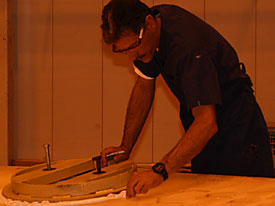 |
|
JON HELGASON/Arizona Daily Wildcat
|
Senior Staff Technician Rick Teachout outlines where the lifting fixture will be placed at the Steward Observatory Mirror Laboratory yesterday. The mirror surface must then be cleaned multiple times.
|
|
By Kaila Wyman
Arizona Daily Wildcat
Wednesday October 9, 2002
Contract for telescope testing device should bring jobs to Tucson
The UA is receiving $22.2 million to create an optical system to test telescopes for Lockheed Martin, President Peter Likins, Tucson Mayor Bob Walkup and other officials announced yesterday afternoon at the Steward Observatory Mirror Laboratory.
The technology, which is expected to be completed in 2006, will allow Lockheed Martin to test telescopes in a vacuum chamber to see how they'd work in space.
The UA will work with Kaman Aerospace to create the optical device ¸ called a collimator ¸ for shipment to defense and military contractor Lockheed Martin's facility in California.
The UA will make the 6.5-meter mirror to be used inside the collimator.
The contract is expected to bring in about a dozen jobs, split between the UA and Kaman, with salaries ranging from $40,000 to $80,000.
"My hope is that this project is the beginning, not the end of this relationship (between UA and Lockheed Martin)," said Peter Strittmatter, a regents' professor and director of the Steward Observatory.
Optics research is a main focal point in UA's mission. For the economy, development in the optics field is necessary for this region of the country, said Dick Powell, vice president of research.
Likins said the UA depends on companies like Lockheed Martin, because UA can't introduce things like the collimator into the marketplace on its own.
He added that he cannot recall any other project that combined the university, its faculty's expertise and a Tucson business to make such an advancement in research.
"No one can do what we are doing, and we have an obligation to get it into the public sector," Powell said.
The UA was selected because of its development during the last 20 years on the high-tech telescopes that will be part of the collimator.
"This has only been possible because we've had 20 years of consistent effort and support," Strittmatter said.
Likins referred to the research project as a breakthrough for the UA and the Tucson community.
"Occasionally, we have these breakthrough developments and we like to get together and celebrate," Likins said.
Walkup said that the relationship between Lockheed Martin and Tucson will make creative things happen.
"It's a great pleasure as the mayor of Tucson to be part of this process," Walkup said.

